One of the reasons crested gecko husbandry is relatively simple is their diet: Crested geckos are one of the easiest reptile species to feed. They don’t require their keepers to meticulously combine vegetables to ensure proper nutrition, nor do they require mice, rats or other large prey, as many snakes and lizards do.
We’ll try to help you learn how to provide your crested gecko with a proper diet below. We’ll not only discuss the things crested geckos eat, but we’ll also explain the proper way to provide your pet with food. We will also discuss some of the common reasons that crested geckos will refuse food, as well as the ways to solve these problems.
What Do Crested Geckos Eat in the Wild?
Crested geckos are omnivorous lizards, who subsist on a combination of plant- and animal-based foods. Unfortunately, little research has been carried out on the specific foods they consume in the wild, but we can make a few educated guesses.
For example, crested geckos are nocturnal, so they probably prey on nocturnal insects more commonly than diurnal species. Various roach species likely represent a significant percentage of their diet, but moths, spiders, and crickets are likely important components of their diet too.
We know that crested geckos also consume fruit and flower nectar, but, as with their invertebrate prey, it isn’t clear which species they typically feed upon.
What Do Pet Crested Geckos Eat?
Most keepers feed their crested gecko a combination of live insects and commercially prepared crested gecko food. They may, for example, provide commercial crested gecko paste to their pet three nights per week and offer their pet insects on the other nights.
Crickets and roaches are the best insects to feed your crested gecko, and they should be the primary insect staples you offer your pet. However, super worms, Phoenix worms, mealworms, wax worms, and silkworms are acceptable to feed your pet from time to time. Just be sure to feed your lizard insects that are no longer than the distance between his eyes to avoid impactions.
Some keepers forego insects entirely and raise their pets on a diet solely comprised of commercial crested gecko foods. However, this is a controversial notion among many crested gecko keepers, who feel that some insect prey is necessary to ensure their pet enjoys a long, healthy life.
The truth of the matter remains unclear. However, most captive lizards will thrive best when provided with a diverse diet. This helps to prevent nutritional deficiencies, and it probably provides some degree of mental stimulation.
Hatchling & Juvenile Crested Geckos Diet
Young crested geckos will thrive on the same type of diet that the adults do. Just be sure that you use appropriately small insects when feeding young lizards. Additionally, it is probably wise to avoid feeding young crested geckos mealworms or super worms to reduce the likelihood of impactions.
Some keepers feed young crested geckos a more insect-based diet than they feed their adults. This may help the young lizards to grow more rapidly, as insects contain an abundance of protein.
Note that hatchling crested geckos will often refuse food for several days following hatching. They’ll survive during this period by living off the resources provided by the egg yolk, which they’ve only recently finished absorbing. Most will begin feeding in three to five days, typically following their first shed.
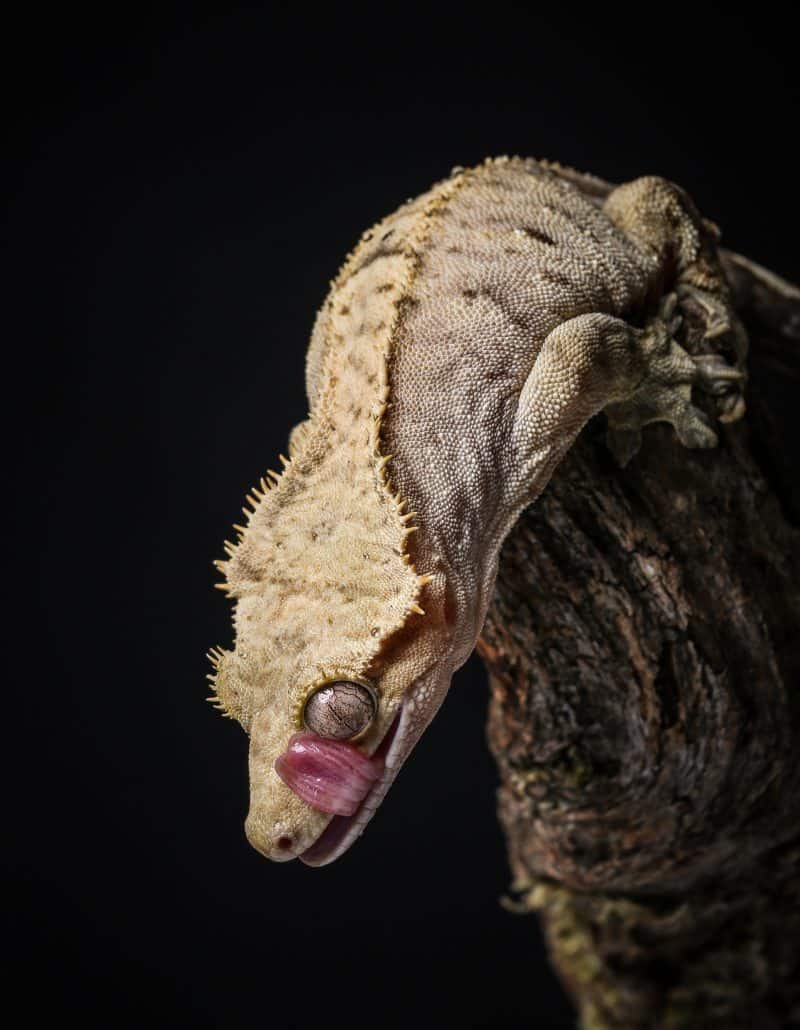
How to Feed a Crested Gecko?
Feeding your crested gecko isn’t difficult, but it entails more than simply chucking a handful of crickets in the enclosure several times per week. You need to learn how to prepare the food properly and present it to your lizard in an acceptable manner.
We’ll talk about offering insects and commercial diets separately.
Preparing and Offering Feeder Insects for Your Crested Gecko
For starters, you’ll want to feed the insects a high-quality diet for at least 24 hours before offering them to your lizard. This mimics the way lizards “get their vegetables” in the wild – they benefit from the food in their prey’s gut. This process, appropriately called “gut loading,” is very important for your lizard’s long-term health.
You can purchase pre-made gut load, or you can simply feed the insects a combination of dark, leafy greens and some type of whole grain. Throw in a carrot or orange slice to provide the insects with water, and you’re all set.
Be sure that you replace your insects’ food frequently so that it doesn’t become contaminated with bacteria or fungi.
You’ll also want to dust your insects with a high-quality calcium supplement. Keepers supplement their feeder insects with calcium powder at varying frequencies, and there is considerable debate about the proper supplementation schedule. Some keepers apply calcium powder to their feeder insects before every feeding, while others do so every other feeding.
Some keepers side-step this issue entirely and simply leave a small dish of calcium in their pet’s enclosure at all times. Most geckos will consume the powder as needed to satisfy their calcium requirements.
Once you are ready to feed your pet, release a small number of insects into the enclosure. Don’t add more insects to the habitat than your crested can eat in about 10 or 15 minutes, as hungry crickets may chew on your gecko’s delicate parts.
It can take a bit of practice to get a feel for the proper number of crickets to provide. Start by introducing just a few at a time. If your lizard greedily eats them all, add a few more. With time, you’ll figure out the approximate number of crickets your pet will eat at a time.
Preparing and Offering Commercial Diets for Your Crested Gecko
Most commercial crested gecko diets come in powdered form. To prepare them, you just mix them with a little water until they develop a pasty consistency. However, be sure to prepare the food exactly as the manufacturer’s instructions indicate.
Once mixed, you can simply place a bit of the food in a shallow dish and add it to your gecko’s enclosure. Different commercial foods are designed to last different lengths of time before they should be removed and discarded. Most, however, remain safe and nutritious for about 24 hours.
Introduce the prepared foods at night, when your gecko will be most active. This way, your pet can enjoy the food while it is as fresh as possible. Remove the uneaten portion the next morning.
How Do Crested Gecko Drink Water?
Crested geckos meet their water requirements through a variety of ways. They absorb some water from the air while breathing, and they also obtain some water from their food. However, you’ll still need to provide fresh drinking water to ensure your pet remains well hydrated.
Unlike leopard geckos and some other lizards that readily recognize and drink standing water, crested geckos typically prefer to drink droplets of water from the sides of their habitat. This means you’ll want to mist your pet’s habitat every day (which is also helpful for maintaining a suitable humidity level in the enclosure).
You can use a simple hand-held misting bottle to spray the habitat. However, keepers who maintain large collections often opt for pressurized spray bottles, such as the type gardeners and landscapers use. Regular tap water is usually safe, but some keepers treat their water with a dechlorinating agent before spraying their pet’s habitat.
Some keepers even use bottled spring water (never use distilled water, as it lacks the mineral content your pet requires), but this is probably not necessary.
Mist your pet’s habitat liberally each morning. Be sure to spray all four sides of the enclosure, as well as any plants in the habitat. Note that while you want to provide a humid habitat for your pet, it is important to allow the enclosure to dry out before you mist it again the next morning. This will help prevent bacteria and fungi from growing in the habitat.
In addition to misting the habitat, some keepers like to leave a dish of fresh water in the enclosure at all times. This is likely a good practice, which will not only help ensure your pet always has access to water, but it will help raise the habitat humidity a bit as well.
> Further Reading: How to Setup the Created Gecko Ideal Enclosure
Why Is My Crested Gecko Not Eating?
Most crested geckos are ravenous eaters, who can’t wait for their nightly feedings. However, keepers will occasionally find that their gecko begins refusing food. This can be a serious problem, so you’ll want to try to figure out the reason this is happening and address the issue promptly.
Some of the most common reasons crested geckos refuse food include the following:
- Inappropriate enclosure temperatures
- Intestinal parasites
- Bacterial infection
- High-stress levels
- Biological changes related to reproduction
The Enclosure Temperatures Are Not Appropriate
Like all other lizards, crested geckos are ectothermic (“cold-blooded”) animals, whose bodily functions vary with the ambient temperatures. If your pet becomes too warm or, more commonly, too cold, he’ll become unable to digest his food properly. This will typically lead to food refusal.
Fortunately, this is an easy problem to rectify. Just reevaluate the way in which you maintain the enclosure temperatures and make the necessary adjustments.
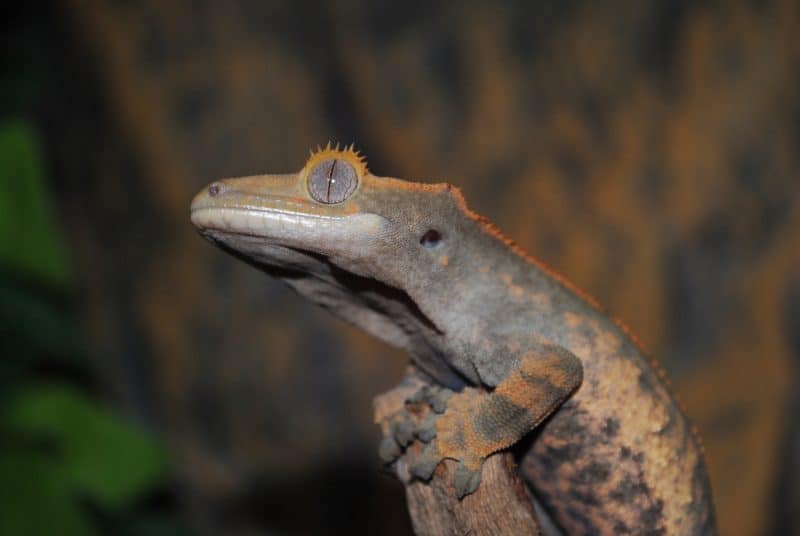
Intestinal Parasites Are Reducing Your Pet’s Appetite
Crested geckos probably don’t suffer from internal parasites as often as some other reptiles in captivity do. This is primarily due to the fact that the vast majority of crested geckos in captivity are captive bred.
However, any pet can become infested with internal parasites, which will often reduce the animal’s desire to eat. You’ll need your veterinarian’s help to eliminate your pet’s parasites. However, with proper treatment, most parasitized geckos will recover fully.
Your Lizard Is Suffering from a Bacterial Infection
Bacterial infections can make your lizard feel unwell and depress his appetite. Bacterial infections precipitate from a variety of causes, but poor hygiene practices are likely the most common.
As with parasites, you’ll need your vet’s help to eliminate bacterial infections. However, most will respond to a course of antibiotics. Just be sure to act promptly, as it may take a week or longer for the antibiotics to work.
> Read More: Crested Gecko Behavior & Health
Your Gecko Is Experiencing High-Stress Levels
Stress will cause many animals to stop eating or to eat less than normal. Accordingly, the first thing you’ll want to do when confronted with a lizard who refuses food is to eliminate any sources of stress. Reduce the amount of time you spend handling your lizard and be sure that your pet has plenty of hiding spaces within the enclosure.
Social factors can also cause crested geckos to refuse food. This is one of the reasons that it is typically wise to house crested geckos singly outside of breeding attempts.
Your Pet Is Currently Experiencing Biological Changes Related to Reproduction
Reproduction can cause crested geckos (and most other reptiles) to temporarily refuse food. Males may be more interested in securing mates and breeding than eating, while females may begin refusing food as developing eggs begin crowding their insides. Fortunately, such lizards usually resume feeding normally within a few days.
> Further Reading: How to Sex a Crested Gecko (Male vs Female)
Bon appétit!
As you can see, feeding crested geckos is pretty easy – especially when compared to some other commonly kept species. In fact, this is a big part of the lizard’s popularity. Just be sure that you embrace the tips and techniques mentioned above to ensure your pet enjoys a nutritious and healthy diet.
We hope this article has helped you to better understand the best way to feed your crested gecko. Be sure to share it with your friends who also enjoy keeping crested geckos if you found it helpful.

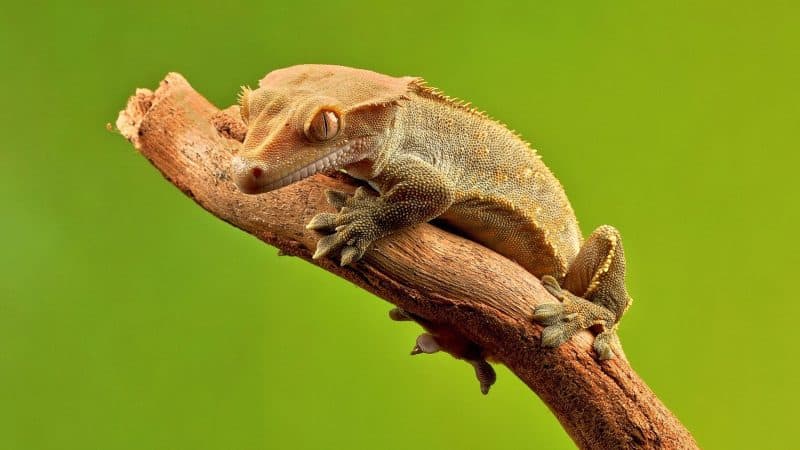






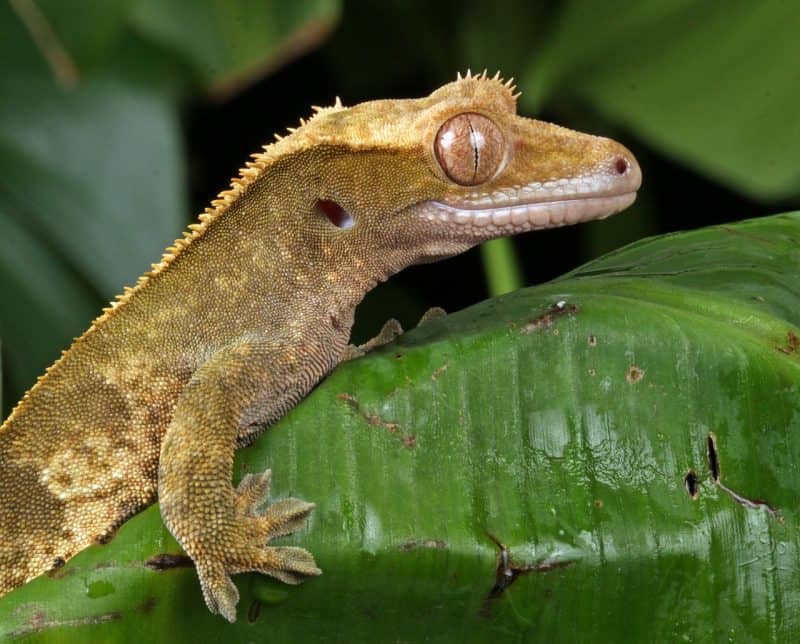
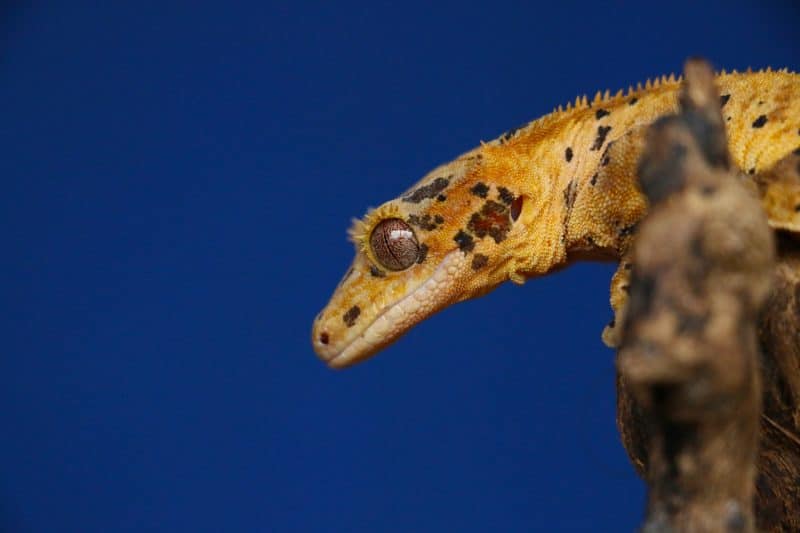
4 Comments
How do I know if my crested gecko powder is a full meal?
Hi Maya,
Check the ingredients list! Look for a balanced blend of vitamins, minerals, and proteins. The powder should contain three main food groups: plant-based protein, calcium from animal sources, and carbohydrates from fruit or vegetables. You can also look for added supplements such as pre/probiotics to give your crested gecko even more nutrition.
If the powder includes any artificial or synthetic ingredients, it’s best to avoid it. If you can see a complete list of ingredients and know what each is for, then you should have a good idea if your crested gecko powder is a full meal.
Hello sir.
I have a veiled chameleon and a young crested gecko can I house the together? I really don’t have any other option.
Thank you
Gary
Hi Gary,
No, I wouldn’t recommend housing the veiled chameleon and young crested gecko together. They have different requirements when it comes to things like temperature, humidity, lighting, diet, and even enclosure size. In addition, they may be aggressive towards each other due to their natural instincts.
I would suggest finding an appropriate enclosure for each species and then making sure that the requirements for each species are met. This will ensure that both your reptiles remain healthy and happy.
If you have any other questions, feel free to let me know, and I will be happy to answer them!